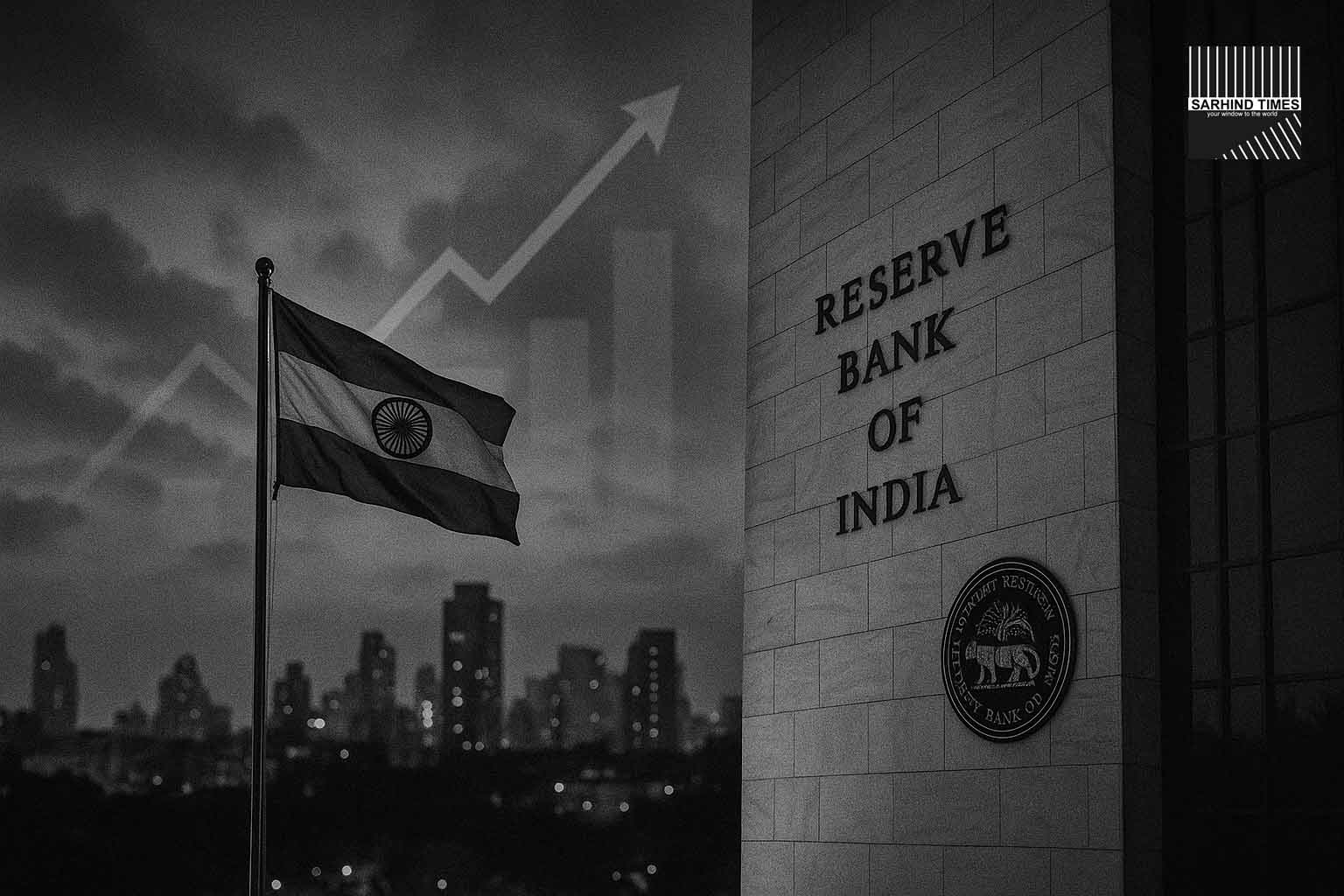Governor Sanjay Malhotra says India’s fundamentals remain robust amid global headwinds
(By Sarhind Times Business & Economy Bureau | October 16, 2025)
Washington / Mumbai — RBI’s Confidence Amid Trade Turbulence
Even as the world grapples with tariff wars, inflationary shocks, and uneven growth, India’s economy remains an outlier of stability and momentum, according to Reserve Bank of India (RBI) Governor Sanjay Malhotra.
Speaking at an IMF panel in Washington, Malhotra emphasized that India’s growth outlook “remains resilient and broad-based,” projecting real GDP expansion of over 8% for FY2025–26, despite new U.S. tariff actions affecting selected export categories.
“India’s domestic drivers are strong enough to absorb short-term global noise. U.S. tariffs are not a huge concern for our growth trajectory,” Malhotra said, underscoring the role of steady investment, robust consumption, and prudent macroeconomic management.
The statement comes at a critical time when the global economic landscape faces heightened uncertainty — from slowing Chinese demand to U.S.–Europe tariff escalations and geopolitical disruptions in shipping and energy markets.
A Message of Stability and Confidence
Governor Malhotra’s remarks served as both reassurance and strategic signaling. Amid global headlines about new U.S. tariffs on Asian imports, India’s central bank sought to calm domestic markets and investors.
“The Indian economy has demonstrated resilience through multiple shocks — from the pandemic to commodity volatility. Our buffers are stronger, our policies are data-driven, and our institutions have matured,” Malhotra added.
His comments align with the RBI’s latest Monetary Policy Review, which kept the repo rate steady while reiterating a “withdrawal of accommodation” stance to balance growth and inflation.
Economists interpret the Governor’s statement as a reaffirmation that India’s growth story is not externally fragile, unlike many emerging economies that rely heavily on export-driven cycles.
Domestic Demand: The Backbone of Growth
At the heart of India’s growth narrative lies its domestic demand engine, which accounts for nearly 60% of GDP.
Private consumption has rebounded strongly post-pandemic, supported by:
- Rising rural incomes, aided by higher agricultural procurement prices and targeted subsidies.
- Urban wage growth, driven by technology, services, and formalization trends.
- Increased capital expenditure, particularly in infrastructure, manufacturing, and real estate.
Recent data from the National Statistical Office (NSO) show that gross fixed capital formation (GFCF) has reached 34% of GDP — the highest in over a decade.
“India’s internal momentum is enough to cushion moderate export headwinds,” said Dr. Saugata Bhattacharya, Chief Economist at Axis Bank. “Even if tariffs pinch a few sectors, domestic investment cycles are on a multi-year uptrend.”
Tariffs and Trade: Contained Exposure
The U.S. tariffs — primarily targeting steel, aluminum, and select manufactured goods — are expected to have limited direct impact on India’s overall growth. Exports account for about 21% of India’s GDP, and U.S.-bound exports comprise roughly 16% of total shipments.
According to the Commerce Ministry, India’s top export categories to the U.S. — including pharmaceuticals, software, diamonds, and textiles — remain largely unaffected by the latest measures.
However, economists caution that prolonged trade tensions could trigger second-order effects such as supply chain delays, higher input costs, and weaker global demand — especially in electronics, auto components, and chemicals.
“Tariffs hurt sentiment more than volumes in the short run,” noted Radhika Rao, Senior Economist at DBS Bank. “But sustained friction could affect export competitiveness and new investment plans.”
IMF Forum: India in the Global Spotlight
At the IMF Annual Meetings, where the RBI Governor shared the stage with finance chiefs from Indonesia, Brazil, and South Africa, the tone was markedly different for India.
While several emerging economies spoke of growth downgrades and inflation pressures, India was repeatedly cited as “the bright spot of the global economy.”
IMF Managing Director Kristalina Georgieva recently lauded India’s “balanced fiscal consolidation and monetary prudence,” emphasizing that “India’s reforms and digital infrastructure provide a global model for inclusive growth.”
Malhotra, echoing this sentiment, pointed out that India’s macro buffers — forex reserves above $650 billion, moderate current account deficit (~1.2% of GDP), and manageable inflation — place it among the most resilient economies globally.
Inflation and Monetary Policy: The Fine Balance
RBI’s policy focus, Malhotra reiterated, is to anchor inflation expectations without stifling growth.
Headline inflation has eased from its 2023 peaks but remains around 4.7%, near the upper half of the RBI’s tolerance band. Food price volatility and global fuel costs continue to pose risks.
However, core inflation — a measure excluding food and fuel — has declined steadily, reflecting effective monetary transmission.
“The goal is steady disinflation without destabilizing credit conditions,” said Malhotra. “We remain vigilant on global spillovers while ensuring domestic liquidity supports productive sectors.”
Markets Respond Positively
Indian markets responded favorably to the RBI’s upbeat tone. The Sensex climbed over 400 points intraday before closing up 0.5%, while the rupee stabilized near 83.20 per dollar.
Banking and infrastructure stocks led the gains, reflecting investor confidence in continued domestic expansion. Bond yields softened marginally as traders interpreted the Governor’s comments as a sign that the central bank would maintain policy continuity.
“It’s a statement of confidence — that India’s growth momentum is self-sustaining,” said Devang Mehta, Head of Equity Strategy at Centrum Wealth. “Global noise won’t derail the story.”
Sectoral View: Who Gains, Who Risks
- Information Technology (IT): Benefiting from global digitization and AI adoption, Indian IT exports remain resilient even amid protectionist trends.
- Manufacturing & Auto Components: Could face mild cost pressures from tariffs but benefit from PLI schemes and China+1 diversification.
- Pharma & Chemicals: Relatively insulated, with growing U.S. demand for generic drugs and intermediates.
- Infrastructure & Energy: Domestic policy thrust ensures strong investment pipelines, independent of trade turbulence.
- Agriculture & Rural Demand: Government spending and MSP support continue to boost rural resilience.
Credit, Capex, and Confidence
India’s bank credit growth continues above 15% year-on-year, led by retail, MSME, and infrastructure lending. The RBI’s stress tests suggest strong banking system health, with gross NPA ratios below 3%.
Corporate balance sheets are healthier, and private investment is picking up after a decade-long lull. Large industrial groups have announced major expansions in green energy, EV manufacturing, and semiconductors — signalling that corporate India is betting on domestic demand longevity.
The Union Government’s capex push — up 30% year-on-year — has created multiplier effects in cement, steel, and logistics. Combined with RBI’s liquidity management, the policy synergy appears to be fueling a new growth cycle.
The Global Context: Learning from Volatility
Global growth forecasts have been trimmed, with the IMF projecting 2.8% world GDP growth for 2025. Developed markets remain constrained by high interest rates, while China’s slowdown continues to weigh on global trade.
In contrast, India’s structural strengths — demographics, consumption base, digital inclusion, and reform momentum — make it less dependent on global cycles.
“The world’s volatility is India’s opportunity,” said Arvind Subramanian, former Chief Economic Adviser. “By staying stable while others oscillate, India attracts capital, talent, and trust.”
Foreign direct investment inflows remain strong, particularly in electronics, renewables, and fintech. Sovereign wealth funds and pension investors view India as a medium-term growth anchor amid global policy fragmentation.
Analysts: Policy Credibility Matters
The RBI’s credibility has been central to sustaining investor confidence. Since 2019, the central bank has successfully managed multiple crises — from pandemic liquidity shocks to currency volatility — without compromising macro stability.
“Markets trust the RBI because it communicates clearly, acts early, and avoids populism,” said Sonali Verma, economist at Nomura. “Governor Malhotra’s calm message in Washington reinforces that trust.”
India’s policy mix — combining fiscal prudence, controlled inflation, and strategic public spending — continues to attract praise from multilateral lenders.
What Lies Ahead
Economists expect the RBI to maintain its current policy stance through the next quarter, watching for external volatility. Potential triggers include:
- Any escalation in U.S.–China trade conflict.
- Oil price volatility amid Middle East tensions.
- Domestic food inflation spikes due to erratic monsoons.
However, most analysts agree that India’s growth outlook above 8% remains achievable unless global trade collapses sharply.
The upcoming Q2 corporate earnings season and the Union Budget 2026 will offer further clarity on investment momentum and fiscal direction.
Conclusion: Confidence in Continuity
Governor Sanjay Malhotra’s message — “India’s growth is durable, not delicate” — encapsulates the spirit of India’s economic trajectory in 2025.
While global economies wrestle with protectionism and policy fatigue, India appears to be scripting its own narrative of sustained expansion, anchored inflation, and inclusive investment.
The RBI’s optimism reflects not complacency but conviction — conviction that India’s next decade of growth will be defined more by its internal dynamism than by external disruptions.
#RBI #IndiaEconomy #Growth #IMF #Tariffs #Inflation #Policy #Macro #SanjayMalhotra #FinancialStability #EconomicResilience #EmergingMarkets






















+ There are no comments
Add yours